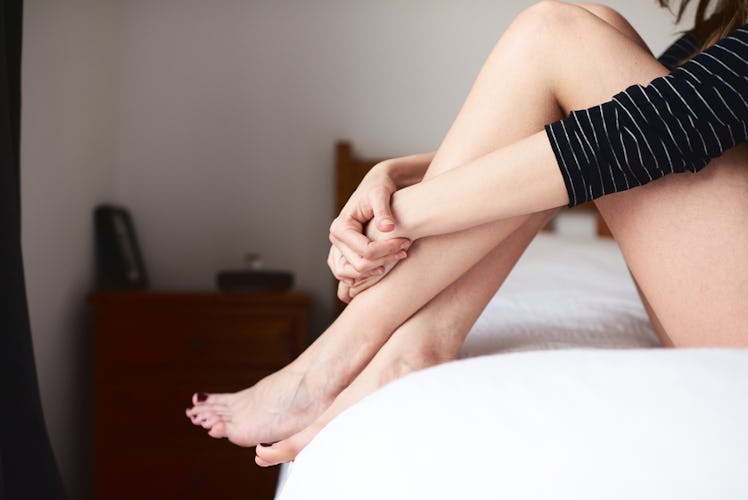
6 Things That'll Soothe A Yeast Infection Itch, & You May Already Have Them In The House
Premenstrual symptoms are arguably the worst thing to happen to the female body, though yeast infections come in at a close second. For those of you who somehow don’t know or have never experienced a yeast infection, it's a genital fungal infection that causes a burning sensation when you pee and vaginal discharge, but the cruelest part of the whole thing is figuring out how to stop a yeast infection from itching. It is, quite literally, the itch you just can’t seem to scratch, no matter how many layers of anti-fungal creams you slather on — which, now that I think about it, might just be the problem.
I’m not at liberty to sit here and accuse this cream or that wash for doing a poor job down there to stop the itch because, in most cases, products get the job done — but only temporarily. Their only function is to stop the itch, not heal the infection, so chances are, store-bought solutions work their magic, but the bacteria from the infection prolongs the itch after the topical ointment wears off. Look, I’m not saying we should boycott soothing lotions entirely. But what I am saying is that it might be time for us to switch gears and consult natural remedies, as well.
Dr. Josh Axe, D.N.M., C.N.S., D.C., founder of DrAxe.com, best-selling author of Eat Dirt, and co-founder of Ancient Nutrition, reports that the majority of anti-fungal drugs feature a chemical compound called azole which a lot of people are sensitive to. According to Axe, "more and more, natural remedies are producing far better results," which means if creams aren't cutting it, we might as well give the following organic alternatives a fair try.
01Probiotics
When I say "probiotics," I don't mean you're about to start popping pills or adding Greek yogurt to your meals. Sorry, friends.
According to a recent study, Italian women with chronic yeast infections inserted a probiotic tablet into the vagina once a night for seven nights, then every three nights for three weeks, and then once a week until the fungal infection subsides.
Despite the fact that these women noticed an 87 percent drop in fungal infections when choosing to follow this method, naturopathic physician and professor at Bastyr University Laurie Cullen, ND told Prevention that you should try to treat an infection with conventional therapy first before trying this strategy at home.
02Garlic
Speaking of things to stick up your vagina in the name of fungal infections, garlic cloves are apparently an option, as well. I mean, I guess if the stinking rose can ward off vampires, it makes sense that it also has the power to beat vaginal pollutants, as well.
Here's how it works: Peel a single garlic clove, and insert it directly into the vagina, keeping it housed in there for a few hours to kill the itch.
03Tea Tree Oil
If there's anything I can say about feminine issues, it's that women will go to great, creative lengths to solve them.
Prevention reports that, because tea tree essential oil has proven to be anti-fungal against yeast, a decent amount of women say that in order to ease yeast infection itching, they leave a tampon doused in tea tree oil in their vaginas to work its magic overnight.
Dr. Cullen, however, suggests taking precaution here, as any woman's private parts are likely to be extremely sensitive. In other words, if there's no method to this madness for your unique vag, don't try this at home.
04Coconut Oil
Considering coconut oil is the solution to all of our beauty woes, it's not surprising this super ingredient also works wonders on a suffering vag.
According to Medical News Today, coconut oil is loaded with anti-fungal properties, and can be applied raw both internally and externally to ward off a gnarly itch. You can also mix warm coconut oil with other essential oils like tea tree and oregano to enhance their healing properties.
05Boric Acid
Since I'm sure you're wondering what the hell that even is, boric acid is a weakened acid of boron, and is generally found in volcanic areas such as Tuscany, Italy, and the state of Nevada. It's commonly used as an antiseptic.
A 2009 study revealed that, when used topically, boric acid can treat vaginal infections, which eventually led to boric acid vaginal suppositories becoming a real thing to subdue yeast infection itch. Specific, no?
According to Healthline, however, because boric acid can be majorly toxic in large amounts, it is highly recommended that you avoid using it on broken skin or taking it orally to prevent "kidney damage, acute failure of the circulatory system, or death."
06Apple Cider Vinegar
If you were skeptical over whether or not ACV really was the end-all-be-all of everything beauty, health, and hygiene-related, here's your proof.
Pour one cup of apple cider vinegar into a full, warm bath, and get cozy underwater for 20 minutes max. Healthline reports that the acidity of the vinegar extracts and eliminates toxic microorganisms, so this is a pretty speedy remedy when the itch get to be a b*tch.